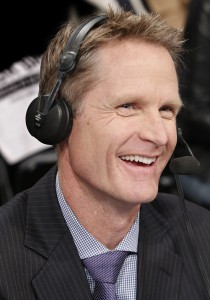David Nixon grew up in Texas, where football is life. An outside linebacker for BYU from 2003 to 2008, Nixon finished his decorated collegiate career with a Mountain West Conference record of 43 tackles for loss. After signing with the Oakland Raiders out of college, Nixon went on to play four years in the NFL. When his playing days ended in 2012, Nixon was snapped up into the world of sports broadcasting — a world that has quickly become the birthplace of a second career for many former athletes.
“Just two years ago I was playing in the NFL and spending hours upon hours with this game,” Nixon said. “It became my profession. So, for me, (broadcasting) is a way to stay connected to it.”

According to the NFL Player’s Association, the average NFL career lasts about 3.5 years. That means while many of their 20-something counterparts are just beginning careers, other young professional football players are retiring.
For some, the answer of what to do for the rest of their lives comes in the form of announcing, reporting and commentating.
ESPN boasts 7,000 employees worldwide in various fields and positions, but most of their on-air analyst and color commentary jobs are filled by former athletes. Locally, approximately half of BYUtv’s on-air personalities for “True Blue” played at the collegiate or professional level.
Kristen Kozlowski played basketball for the Cougars under current head coach Jeff Judkins from 2002 to 2005. The thought of a career in sports broadcasting had never crossed Kozlowski’s mind, who graduated with a degree ini psychology.
“When I graduated, the BYUtv producer called me up and said they needed a color analyst for women’s basketball, so I jumped right in,” Kozlowski said. “A couple of the first games I did, I called them with Holly Rowe (who currently works for ESPN), and we worked really close. I was nervous, but Holly was like, ‘You’re really good at this; you should pursue this!’”
Kozlowski does color commentary for women’s volleyball, basketball and softball, in addition to raising four little boys. She believes an athletic background prepares broadcasters for their career.
“Because I was an athlete, I’m able to give viewers more insight to what it’s like out there — in emotionally intense parts of the game, or when the team needs to have more intensity, or maybe just what’s going through Coach Judkins’ head since I played for him and know his system really well,” Kozlowski said.
Former athletes have more than just analytical advantages. Connections forged during their career can become lifelines to a second career when their playing days are over. Not only that, but a famous face can pique consumers’ interests as well as add credibility to their commentary. Experience interacting with the media provides them with inside knowledge of norms and expectations, which often enhances their sports talk.
In 2009, ESPN introduced a program that trains former athletes in voice, presentation and other necessary skills, essentially creating a direct pipeline for athletes to go from the interviewee’s seat to the interviewer’s.
Famous athletes like Charles Barkley, Steve Kerr, Tim Tebow and Steve Young have added personality and life to NBA and NFL commentary teams. For someone like Tebow, it is a chance to stay in the spotlight and succeed in new ways amidst a floundering career in the NFL.
For some former athletes, like Kerr, broadcasting is merely an interim before returning to sports. After working as a broadcaster for TNT, Kerr was introduced as the new head coach of the Golden State Warriors on May 14.
BYU broadcast journalism professor Robert Walz has thirty years of experience reporting news. According to Walz, the sports journalism field is looking bleak for non-athletes.
“When you go out to compete in the world of sports journalism, who would the network rather hire to do commentary — someone who is just out of a journalism school, or somebody who has been working as a professional athlete?” Walz said.
However, this specialization has caused growth too.
“There is a lot of growth in the sports field, in that a lot of teams are starting their own networks,” Walz said. “It used to be that networks like CBS or NBC would bid to see who could cover the NBA. Now, they’ve got their own network, they hire their own people and make money off of it.”
Walz said sports reporters can find a niche in local sports, but the national-level jobs will continue to go to former athletes.
Nixon believes the trend will continue.
“I think former athletes are able to bring their experience to the table,” Nixon said. “They’re able to relate to the players, which brings a whole new depth to their analysis. I think some of the best commentary is sharing your own experiences that relate to what is going on out on the field.”




